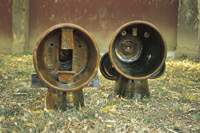Štefan Oriško
Several lively events have recently been created for lovers of ceramics: the annual symposia, and Slovak ceramic shows that take place every three years. Not many fields of artistic creations in Slovakia regularly exhibit for their audience. This year, not only did both event cycles meet at the same time, but several others joined them too. The Ceramic symposium in Lučenec (July – August 2003) is already celebrating its fifteenth year and, as such, is the longest-existing symposium in Slovakia. It took place in the factory for heat resistant materials in Kalinovo (Žiaromat). Although the requirement for extremely high heat and fireproof clay reduce expressive the possibilities for ceramics, these technical deficiencies have become opportunities for the current symposium – they focus participants’ interest in clay as a primary material: using it is a matter of the author’s approach. The symposium has been reshaped in recent years to concentrate on small teams, whereby domestic authors host foreign ones. Last year’s foreign participation was represented by Czech ceramic makers, while this year it will be Polish authors, pedagogues from the Academy of Fine Arts in Wroclaw. Exhibition Slovak Ceramics Nowadays IV The Slovak Ceramics exhibition (Prešov, October – November, Trenčín, December 2003 – January 2004) has evaluated the status of ceramic creation for the fourth time. At the same time, it reflected the events and activities of the Association of Ceramic Makers for the past three years. Its intention is to present members of the Association of Ceramic makers with their small collections without regard to their artistic orientation, generation or the functionality of their works. Therefore, a large number of opinions from simple design through decorative works, various forms of ceramic (clay) objects up to experiments in the sphere of ceramic installation all come together at the exhibition. This year’s exhibition had a specific focus: it was devoted to the remembrance and contribution of Teodor Lugs in the history of Slovak ceramics of the twentieth century. The selection from his life’s work was a special collection; his influence and the impact of his artistic opinions remain in the work of many Slovak ceramic makers, whom he influenced as an inventive pedagogue. The largest number of authors so far participated in the current exhibition. The activity of authors who have entered the world of ceramics since the 1960s in several waves of generations (influenced by Prague schools) and significantly contributed to making ceramics equal to other types of artistic works remains surprisingly alive and inventive. More than just a promise was the participation of the youngest generation of participants, one of the first graduates of the ceramic studio of the University of Fine Arts in Bratislava. This studio, functioning only since 1990s, fulfilled the endeavour for emancipation of Slovak ceramics in the field of specialized education. Biennale in Kapfenberg The Ceramic Biennale in Austrian Kapfenberg (26 September – 30 November) is also held outside the main artistic centres. During the last three years, however, it has caught the attention of European ceramic makers, and therefore a large ceramic community met here as guests, visitors, as well as the committee: directors of museums, galleries of contemporary ceramics (gallery representatives from Frechen, Stuttgart and Austria), magazine publishers as well as “star” guests, for example, Enrico Mestre. Important names also featured in the committee proposing participants (this time, for example, Swedish Ulla Viotti, Günther Praschak from Linz, or the director of Frechen Keramion Peter W. Bürkner). The Biennale itself normally takes place without international stars – its task is to promote promising performance and “discoveries” from individual participating countries with recommendations by famous colleagues. For spatial reasons, participation by national ceramics from Europe is variable, and the biennale is changing its location: Slovakia exhibited last time; this time it only had a representative on the committee (I. Langerová-Vidrová). The statues of Otto Korkoš passed the strict criteria of the committee in Italian Faenza.
